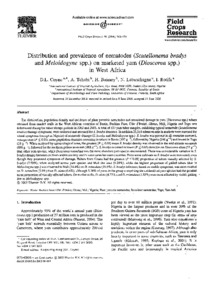| dc.contributor.author | Coyne, D.L. |
| dc.contributor.author | Tchabi, A. |
| dc.contributor.author | Baimey, H. |
| dc.contributor.author | Labuschagne, N. |
| dc.contributor.author | Rotifa, I. |
| dc.date.accessioned | 2019-12-04T11:18:08Z |
| dc.date.available | 2019-12-04T11:18:08Z |
| dc.date.issued | 2006 |
| dc.identifier.citation | Coyne, D.L., Tchabi, A., Baimey, H., Labuschagne, N. & Rotifa, I. (2006). Distribution and prevalence of nematodes (Scutellonema bradys and Meloidogyne spp.) on marketed yam (Dioscorea spp.) in West Africa. Field Crops Research, 96(1), 142-150. |
| dc.identifier.issn | 0378-4290 |
| dc.identifier.uri | https://hdl.handle.net/20.500.12478/3072 |
| dc.description.abstract | The distribution, population density and incidence of plant parasitic nematodes and associated damage to yam (Dioscorea spp.) tubers obtained from market stalls in the West African countries of Benin, Burkina Faso, Côte d’Ivoire, Ghana, Mali, Nigeria and Togo was determined during the tuber storage periods in 2002 and 2003. A total of 527 yam tuber samples, exhibiting typical nematode (Scutellonema bradys) damage symptoms, were collected and assessed for S. bradys densities. In addition 25,318 tubers on sale in markets were assessed for visual symptoms (except in Nigeria) of nematode damage (S. bradys and Meloidogyne spp.). S. bradys was present in all countries assessed, with greatest (P ≤ 0.05) mean population densities occurring in tubers in Benin (397 g−1), followed by Nigeria (248 g−1) and lowest in Togo (28 g−1). When analysed by agroecological zone, the greatest (P ≤ 0.05) mean S. bradys density was observed in the mid altitude savannah (890 g−1), followed by the southern guinea savannah (488 g−1). S. bradys occurred in lower (P ≤ 0.05) densities on Dioscorea alata (57 g−1) than other yam species, while Dioscorea rotundata was the most abundant yam species encountered. There was considerable variation in S. bradys density between cultivars within country and in some cases between countries. From some cultivars no S. bradys were recovered, even though they presented symptoms of damage. Tubers from Ghana had the greatest (P ≤ 0.05) proportion of tubers visually affected by S. bradys (7.53%), when analysed across yam species and Mali the least (0.28%), while the highest proportion of galled tubers (due to Meloidogyne spp.) was observed in Mali (14.4%) on D. rotundata (19.6%). S. bradys infection, based on visible symptoms, was more evident on D. rotundata (3.8%) than D. alata (0.6%), although 5.18% of yams in the group comprising the unidentified yam species had the greatest mean proportion of visually affected tubers. On market stalls, D. alata (4.73%) and D. rotundata (3.35%) were most affected by visible galling due to Meloidogyne SPP. |
| dc.description.sponsorship | United States Agency for International Development |
| dc.language.iso | en |
| dc.subject | Côte D'Ivoire |
| dc.subject | Plant Parasitic Nematodes |
| dc.subject | Root-Knot Nematodes |
| dc.subject | Togo |
| dc.subject | Yam Belt |
| dc.title | Distribution and prevalence of nematodes (Scutellonema bradys and Meloidogyne spp.) on marketed yam (Dioscorea spp.) in West Africa |
| dc.type | Journal Article |
| dc.description.version | Peer Review |
| cg.contributor.affiliation | International Institute of Tropical Agriculture |
| cg.contributor.affiliation | University of Pretoria |
| cg.coverage.region | Africa |
| cg.coverage.region | West Africa |
| cg.coverage.region | Southern Africa |
| cg.coverage.country | Nigeria |
| cg.coverage.country | Benin |
| cg.coverage.country | South Africa |
| cg.isijournal | ISI Journal |
| cg.authorship.types | CGIAR and developing country institute |
| cg.iitasubject | Food Security |
| cg.iitasubject | Livelihoods |
| cg.iitasubject | Diseases Control |
| cg.iitasubject | Plant Breeding |
| cg.iitasubject | Plant Production |
| cg.iitasubject | Plant Genetic Resources |
| cg.iitasubject | Farm Management |
| cg.iitasubject | Pests Of Plants |
| cg.iitasubject | Handling, Transport, Storage And Protection Of Agricultural Products |
| cg.accessibilitystatus | Limited Access |
| local.dspaceid | 94538 |
| cg.identifier.doi | https://dx.doi.org/10.1016/j.fcr.2005.06.004 |

